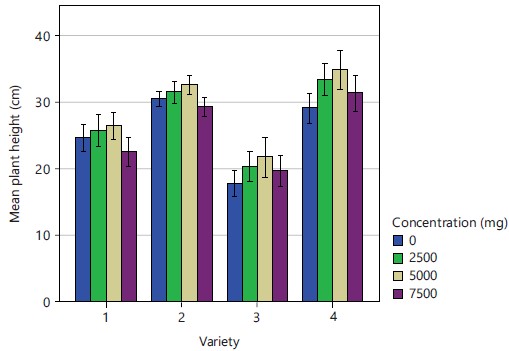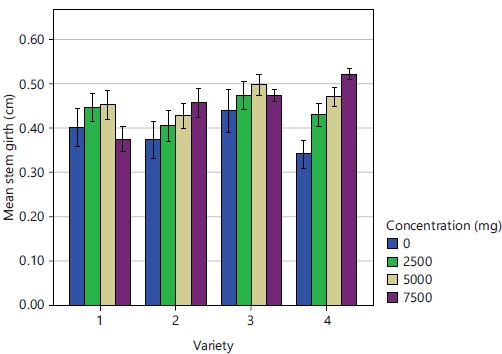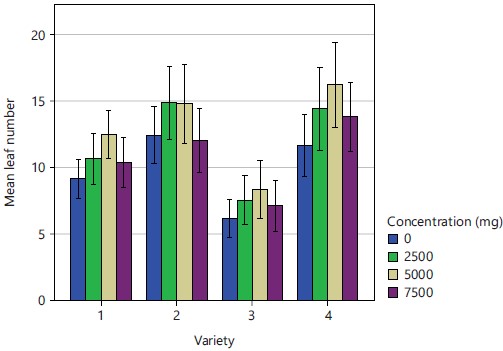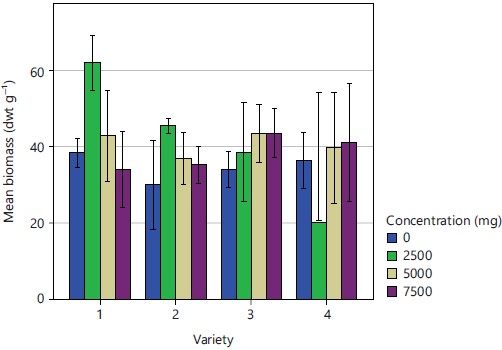Growth Responses of Phaseolus vulgaris Linn. to Different Concentrations of Silicon in Calabar, Nigeria
| Received 20 Dec, 2022 |
Accepted 14 Apr, 2023 |
Published 01 Jun, 2023 |
Background and Objective: Silicon (Si), although, not considered essential for plants, has been shown to have beneficial effects on plant growth, and productivity. This study investigated the impact of silicon on the growth and yield of four varieties of Phaseolus vulgaris L., IT99K-573-1-1 (variety 1), IT99K-573-2-1 (variety 2), IT960-610 (variety 3), and IT97K-499-35 (variety 4). Materials and Methods: A randomized complete block design was used. Five seeds of each variety were sown in polythene bags containing soil and thinned to one after germination. The plants were treated with silicon at 2500, 5000 and 7500 mg, and control, and growth parameters were measured bi-weekly for 10 weeks. Results: The silicon application had a significant positive effect on all growth parameters and shoot biomass. The highest mean plant height and leaf number were observed in IT97K-499-35 (32.18, 13.98 cm), while IT99K-573-2-1 had the highest mean leaf area (65.05 cm2), IT960-610 had the highest mean stem girth (0.47 cm) and IT99K-573-1-1 had the highest mean shoot biomass (44.18 gm‾2). Conclusion: These findings showed that silicon application boosts crop growth parameters and shoots biomass, indicating positive effects. Adding silicon to soil and nutrient medium may enhance P. vulgaris L. and other crop growth and yield.
| Copyright © 2023 Paul and Ogheneriruona. This is an open-access article distributed under the Creative Commons Attribution License, which permits unrestricted use, distribution, and reproduction in any medium, provided the original work is properly cited. |
INTRODUCTION
Silicon (Si), a naturally abundant element found in the earth’s crust, plays a crucial role in plant nutrition. However, its availability to plants is influenced by various factors, including biogeochemical cycling, mineral form and solubility1. Among the different forms of Si accessible to plants, the primary soluble form is mono silicic acid (Si(OH)4)2. It is worth noting that the continuous removal of Si from agricultural fields through crop harvests can deplete the available Si pool in the soil over time3. For instance, rice and sugarcane, belonging to the Poaceae family, are known for their significant Si accumulation, with reports indicating the removal of 470 and 700 kg of Si per hectare in Si-rich soils, respectively4, resulting in a need for Si fertilization to ensure optimal plant growth. Although Si is not classified as an essential element for plants, numerous studies have highlighted its beneficial effects on plant growth and performance, particularly when faced with conditions of limited nutrient availability5. Additionally, Si has been recognized as an inducer of plant defense mechanisms and an inhibitor of insecticide resistance, presenting an intriguing potential for pest management strategies6. In addition to its role in plant development, silicon (Si) also plays a significant role in the human diet and has been associated with strengthening bones and connective tissues, as well as reducing the risks of some diseases7. However, it is important to consider that the ability of different plant species and genotypes to accumulate silicon can vary significantly8. Thus, this study aimed to assess the effects of Si on the growth and performance of four different varieties of Phaseolus vulgaris L. (common bean) in Calabar, Nigeria. By exploring the responses of these Phaseolus vulgaris varieties to different concentrations of Si, valuable insights can be gained regarding the potential benefits and limitations of Si supplementation for improving crop productivity in this region.
MATERIALS AND METHODS
The study was conducted at the experimental plot of the botanical gardens at the University of Calabar, Cross River State, Nigeria from June to August, 2014. The experiment was laid out in a 4×4 factorial, involving four varieties of P. vulgaris L., IT99K-573-1-1 (variety 1), IT99K-573-2-1 (variety 2), IT960-610 (variety 3) and IT97K-499-35 (variety 4) and three silicon concentrations along with a control (0, 2500, 5000 and 7500 mg). The experimental design used was a Randomized Complete Block Design (RCBD) with four replications, resulting in a total of 64 experimental units/bags. The P. vulgaris varieties were collected from the International Institute of Tropical Agriculture (IITA) in Ibadan, Oyo State in Nigeria.
Soil samples were collected randomly from the experimental plot at a depth of 15 cm using a tube auger from three different locations, which were then combined to form a composite mixture. The soil was passed through a 0.5×0.5 cm wire mesh to remove any large soil particles and improve soil aeration. Each polythene bag was filled with 10 kg of the prepared soil. The composite soil mixture collected from the experimental plot was transported to the Soil Science Laboratory in the Faculty of Agriculture at the University of Calabar for analysis.
Five seeds of each variety were sown per polythene bag and thinned to one, seven days after germination. The plants were treated with silicon 2 weeks after germination by broadcasting around the base of the plant and watering afterward.
The growth parameters of the plants were measured bi-weekly for 10 weeks. Plant height, leaf area, leaf number and stem girth were the growth parameters evaluated. Plant height was measured using a measuring tape from the base of the plant at the soil level to the apex. The leaf area was determined by measuring the longest length and width of the leaflets using a meter rule, averaged and multiplied by a correction factor of 0.759. The leaf number was counted by visually counting all leaves on the plant, while the stem girth was measured with a Vernier caliper. The yield was estimated based on the shoot biomass, which was determined by the dry matter content of the shoot, including leaves and stems in each experimental unit. The roots were removed and the fresh shoots were dried in an oven at 80°C for 48 hrs.
Statistical analysis: The weight of dry matter was measured using a weighing balance. Model FA2204T (W&J Instrument Co., Ltd., Jiangsu Province, China). The data collected in this study underwent statistical analysis using ANOVA at a significance level of p = 0.05.
RESULTS
The results of the analysis of the physical and chemical properties of the soil samples collected from the experimental plot as shown in Table 1. The analysis showed values for various parameters including silicon (481.90 mg kg–1), pH, total nitrogen, magnesium, organic carbon, calcium, base saturation (BS), sodium, hydrogen ion, available phosphorus, effective cation exchange capacity (ECEC), potassium, clay, silt, sand and aluminum.
The statistical analysis revealed that there was no significant variation in the interaction between plant height and variety. Variety 4 exhibited the highest average plant height, followed by variety 2, while variety 3 had the lowest average plant height. However, a significant difference was observed in the interaction between plant height and silicon concentration (p<0.05). The highest average plant height was observed at a silicon concentration of 5000 mg, followed by 2500 mg across all varieties (Fig. 1). The results indicated no significant difference in the interaction between leaf area and variety but variety 2 displayed the highest average leaf area, followed by variety 1, with variety 3 exhibiting the lowest average leaf area.
| Table 1: | Physical and chemical properties of soil collected from the experimental plot in the botanical garden, University of Calabar, Nigeria | |||
| Parameter | Value |
| pH | 6.3 |
| Organic carbon | 1.02% |
| Total nitrogen | 0.08% |
| Available phosphorus | 31.25 mg kg–1 |
| Calcium | 5.8 cmol kg–1 |
| Magnesium | 1.00 cmol kg–1 |
| Potassium | 0.15 cmol kg–1 |
| Sodium | 0.09 cmol kg–1 |
| Aluminium | 0.00 cmol kg–1 |
| Hydrogen ion | 0.44 cmol kg–1 |
| Effective cation exchange capacity (ECEC) | 7.19 cmol kg–1 |
| Base saturation (BS) | 91.00% |
| Clay | 3.80% |
| Silt | 14.20% |
| Sand | 82.00% |
| Silicon | 481.90 mg kg–1 |

|
However, there was a significant difference (p<0.05) in the interaction between leaf area and silicon concentration. The highest mean leaf area was observed at 2500 mg in variety 2, followed by 5000 mg concentrations in variety 1, while the least mean leaf area was observed at 7500 mg (Fig. 2). There was no significant difference in the mean stem girths of all varieties. Variety 3 had the highest mean stem girth, followed by variety 4 and the least mean stem girth was observed in variety 2. There was also no significant difference between stem girth and the various concentrations of silicon. The highest mean stem girth was observed at 7500 mg concentration of silicon and the least was observed at 2500 mg silicon concentrations (Fig. 3). The mean number of leaves produced in all varieties did not show any significant difference. Variety 4 had the highest mean leaf number, followed by variety 2 and the least mean leaf number was observed in variety 3. A significant difference was found in the interaction between leaf number and silicon concentration (p<0.05). The highest average leaf number was observed at a silicon concentration of 5000 mg, followed by 2500 mg, while the lowest average leaf number was observed at 7500 mg silicon concentrations (Fig. 4). The results of the study showed a significant difference (p<0.05) in biomass among the different varieties and silicon concentrations.

|

|

|

|
Variety 1 had the highest mean biomass while variety 2 had the least mean biomass. In terms of silicon concentration, the highest mean biomass was observed at 2500 mg, while the least mean biomass was observed at 7500 mg (Fig. 5).
DISCUSSION
This study aimed to investigate the effects of different concentrations of silicon (2500, 5000 and 7500 mg) on the growth and yield of four P. vulgaris L. varieties. The results showed a significant boost in most parameters with the application of silicon compared to the control group. These findings align with previous reports of a positive impact of organic or inorganic nutrient sources on P. vulgaris L. growth and productivity10. Also, this study’s findings support previous reports on the beneficial effects of silicon on crop productivity, abiotic stress response and nutrient uptake11,12. Silicon has been reported to contribute to the balanced nutrition of crops by improving nutrient uptake, leading to enhanced growth13-15. At concentrations of 5000 and 2500 mg of silicon, plant height in all four varieties increased significantly (p<0.05). This finding is consistent with previous research on the impact of silicon on plant height for various crop species16-19. Leaf area in all four varieties significantly increased (p<0.05) at concentrations of 2500 and 5000 mg of silicon. Numerous studies have reported the beneficial impact of silicon amendments on the leaf area of some plants20,21. The increased production of larger leaf area at various silicon concentrations compared to the control may be due to the modification of growth regulator balances by silicon application, favoring leaf expansion. This expansion may have impacted the photosynthetic efficiency, which may directly influence growth and dry matter production22. The impact of silicon application on stem girth varied among all four varieties. Varieties 2 and 4 had the highest stem girths at 7500 mg silicon concentration, while, variety 1 had the least stem girth at the same silicon concentration. However, 5000 mg and 2500 mg concentrations of silicon maintained a consistent trend in all varieties. These differences among the varieties may be due to physiological differences in mineral uptake and accumulation rates of silica on the surface of the epidermal cell wall in the form of a silica gel layer, causing the stem to become thicker and stronger23. In all the varieties evaluated in this study, leaf numbers significantly increased at 2500, 5000 and 7500 mg concentrations of silicon when compared to the control. This may have been due to the improvement of organogenesis within the plants at these concentrations of silicon leading to the formation of more leaves24. The shoot biomass was used to estimate yield and significant interactions were observed between varieties, yield and silicon concentrations, respectively. The shoot biomass, significantly increased at all levels of silicon concentration (2500, 5000 and 7500 mg) in all varieties (p<0.05). The observed increase in biomass is likely due to the role of silicon in the production of higher levels of chlorophyll and stress tolerance, potentially leading to improved photosynthesis25. Other studies have also shown that silicon supplementation showed positive effects on the growth, biomass, yield, pollination and physiological attributes of plants26,27. The addition of silicon at different concentrations, particularly those identified in this study, has proved advantageous for P. vulgaris L. by promoting vegetative growth and overall productivity28. However, further studies are required to understand the role of silicon in plant growth, development and productivity in more detail taking into account, location and species differences.
CONCLUSION
The results of this study suggest that silicon application to P. vulgaris L. has significant positive effects on the growth and yield parameters. The increase in plant height, leaf area, stem girth, leaf number and shoot biomass in response to silicon application is indicative of the essentiality of silicon for the growth and development of plants. Therefore, supplementing the nutrient medium with appropriate levels of silicon could be an effective strategy for improving the growth and yield of P. vulgaris L. and other food crops.
SIGNIFICANCE STATEMENT
The study provides evidence for the essentiality and beneficial effects of silicon on the growth and yield of legume crops. The results have implications for developing sustainable agriculture practices that incorporate silicon fertilizers to improve crop productivity, particularly in regions where silicon is deficient in soils. Further research is needed to determine the optimal concentration of silicon for different P. vulgaris L. varieties and the most effective method of application. These findings have implications for farmers and policymakers who seek to improve crop productivity and food security.
ACKNOWLEDGMENTS
We would like to thank the staff of the Soil Science Laboratory, Faculty of Agriculture, University of Calabar, Nigeria. I would also like to thank the staff and management of IITA for the P. vulgaris L. varieties used in this study.
REFERENCES
- Imtiaz, M., M.S. Rizwan, M.A. Mushtaq, M. Ashraf and S.M. Shahzad et al., 2016. Silicon occurrence, uptake, transport and mechanisms of heavy metals, minerals and salinity enhanced tolerance in plants with future prospects: A review. J. Environ. Manage., 183: 521-529.
- Keeping, M.G., 2017. Uptake of silicon by sugarcane from applied sources may not reflect plant-available soil silicon and total silicon content of sources. Front. Plant Sci., 8: 00760.
- Coskun, D., R. Deshmukh, H. Sonah, J.G. Menzies and O. Reynolds et al., 2019. The controversies of silicon's role in plant biology. New Phytol., 221: 67-85.
- Pardo, J., C.M. Wai, H. Chay, C.F. Madden, H.W.M. Hilhorst, J.M. Farrant and R. van Buren, 2020. Intertwined signatures of desiccation and drought tolerance in grasses. Proc. Nat. Acad. Sci. USA, 117: 10079-10088.
- Pavlovic, J., L. Kostic, P. Bosnic, E.A. Kirkby and M. Nikolic, 2021. Interactions of silicon with essential and beneficial elements in plants. Front. Plant Sci., 12: 697592.
- Wang, J., R. Xue, X. Ju, H. Yan and Z. Gao et al., 2020. Silicon-mediated multiple interactions: Simultaneous induction of rice defense and inhibition of larval performance and insecticide tolerance of Chilo suppressalis by sodium silicate. Ecol. Evol., 10: 4816-4827.
- Devanna, B.N., R. Mandlik, G. Raturi, S.S. Sudhakaran and Y. Sharma et al., 2021. Versatile role of silicon in cereals: Health benefits, uptake mechanism, and evolution. Plant Physiol. Biochem., 165: 173-186.
- Greger, M., T. Landberg and M. Vaculík, 2018. Silicon influences soil availability and accumulation of mineral nutrients in various plant species. Plants, 7: 41.
- Agbogidi, O.M. and E.O. Egho, 2012. Evaluation of eight varieties of cowpea (Vigna unguiculata (L.) Walp) in Asaba agro-ecological environment, Delta State, Nigeria. Eur. J. Sustainable Dev., 1: 303-314.
- Elka, E. and F. Laekemariam, 2020. Effects of organic nutrient sources and NPS fertilizer on the agronomic and economic performance of haricot bean (Phaseolus vulgaris L.) in Southern Ethiopia. Appl. Environ. Soil Sci., 2020: 8853552.
- Artyszak, A., 2018. Effect of silicon fertilization on crop yield quantity and quality-A literature review in Europe. Plants, 7: 7030054.
- Neu, S., J. Schaller and E.G. Dudel, 2017. Silicon availability modifies nutrient use efficiency and content, C:N:P stoichiometry, and productivity of winter wheat (Triticum aestivum L.). Sci. Rep., 7: 40829.
- Murillo-Amador, B., S. Yamada, T. Yamaguchi, E. Rueda-Puente and N. Avila-Serrano et al., 2007. Influence of calcium silicate on growth, physiological parameters and mineral nutrition in two legume species under salt stress. J. Agron. Crop Sci., 193: 413-421.
- Kovács, S., E. Kutasy and J. Csajbók, 2022. The multiple role of silicon nutrition in alleviating environmental stresses in sustainable crop production. Plants, 11: 11091223.
- Olle, M., 2020. Silicon in a sustainable cropping system. Proc. Latv. Acad. Sci. Sect. B. Nat. Exact Appl. Sci., 74: 165-170.
- Meena, V.D., M.L. Dotaniya, V. Coumar, S. Rajendiran, Ajay, S. Kundu and A.S. Rao, 2014. A case for silicon fertilization to improve crop yields in tropical soils. Proc. Natl. Acad. Sci., India Sect. B: Biol. Sci., 84: 505-518.
- Dorairaj, D., M.R. Ismail, U.R. Sinniah and T.K. Ban, 2017. Influence of silicon on growth, yield and lodging resistance of MR219, a lowland rice of Malaysia. J. Plant Nutr., 40: 1111-1124.
- Sah, S.K., K.R. Reddy and J. Li, 2022. Silicon enhances plant vegetative growth and soil water retention of soybean (Glycine max) plants under water-limiting conditions. Plants, 11: 1687.
- Abdul Qados, A.M.S. and A.E. Moftah, 2015. Influence of silicon and nano-silicon on germination, growth and yield of faba bean (Vicia faba L.) under salt stress conditions. Am. J. Exp. Agric. Int., 5: 509-524.
- Pitann, B., H.F. Bakhat, A. Fatima, S. Hanstein and S. Schubert, 2021. Silicon-mediated growth promotion in maize (Zea mays L.) occurs via a mechanism that does not involve activation of the plasma membrane H+-ATPase. Plant Physiol. Biochem., 166: 1121-1130.
- Ononyume, M.O., E.A. Edu, T. Okoh and A.P. Inegbedion, 2017. Evaluation of growth performances of some locally farmed maize (Zea mays L.) in cross River State, Nigeria under different concentrations of silicon. Pak. J. Boil. Sci., 20: 47-51.
- Shen, Z., X. Cheng, X. Li, X. Deng, X. Dong, S. Wang and X. Pu, 2022. Effects of silicon application on leaf structure and physiological characteristics of Glycyrrhiza uralensis Fisch. and Glycyrrhiza inflata Bat. under salt treatment. BMC Plant Biol., 22: 390.
- Sahebi, M., M.M. Hanafi, A.S.N. Akmar, M.Y. Rafii and P. Azizi et al., 2015. Importance of silicon and mechanisms of biosilica formation in plants. BioMed Res. Int., 2015: 396010.
- Sahebi, M., M.M. Hanafi and P. Azizi, 2016. Application of silicon in plant tissue culture. In vitro Cell. Dev. Biol. Plant, 52: 226-232.
- Ligaba-Osena, A., W. Guo, S.C. Choi, M.A. Limmer, A.L. Seyfferth and B.B. Hankoua, 2020. Silicon enhances biomass and grain yield in an ancient crop tef [Eragrostis tef (Zucc.) Trotter]. Front. Plant Sci. 11.
- Ahire, M.L., P.S. Mundada, T.D. Nikam, V.A. Bapat and S. Penna, 2021. Multifaceted roles of silicon in mitigating environmental stresses in plants. Plant Physiol. Biochem., 169: 291-310.
- Ali, N., E. Réthoré, J.C. Yvin and S.A. Hosseini, 2020. The regulatory role of silicon in mitigating plant nutritional stresses. Plants, 9: 1779.
- Guntzer, F., C. Keller and J.D. Meunier, 2012. Benefits of plant silicon for crops: A review. Agron. Sustainable Dev., 32: 201-213.
How to Cite this paper?
APA-7 Style
Paul,
A.I., Ogheneriruona,
M.O. (2023). Growth Responses of Phaseolus vulgaris Linn. to Different Concentrations of Silicon in Calabar, Nigeria. Research Journal of Botany, 18(1), 28-35. https://doi.org/10.3923/rjb.2023.28.35
ACS Style
Paul,
A.I.; Ogheneriruona,
M.O. Growth Responses of Phaseolus vulgaris Linn. to Different Concentrations of Silicon in Calabar, Nigeria. Res. J. Bot 2023, 18, 28-35. https://doi.org/10.3923/rjb.2023.28.35
AMA Style
Paul
AI, Ogheneriruona
MO. Growth Responses of Phaseolus vulgaris Linn. to Different Concentrations of Silicon in Calabar, Nigeria. Research Journal of Botany. 2023; 18(1): 28-35. https://doi.org/10.3923/rjb.2023.28.35
Chicago/Turabian Style
Paul, Akhere, Inegbedion, and Martin Ononyume Ogheneriruona.
2023. "Growth Responses of Phaseolus vulgaris Linn. to Different Concentrations of Silicon in Calabar, Nigeria" Research Journal of Botany 18, no. 1: 28-35. https://doi.org/10.3923/rjb.2023.28.35

This work is licensed under a Creative Commons Attribution 4.0 International License.



